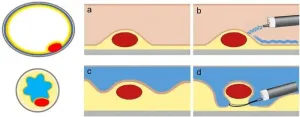(Press-News.org)
Neuroendocrine tumors (NETs) of the gastrointestinal (GI) tract are a rare and heterogeneous group of malignancies arising from the neuroendocrine cell system. These tumors are more commonly encountered in the stomach, appendix, small bowel, rectum, and pancreas. Over the past few decades, the incidence of GI NETs has increased due to improved diagnostic capabilities and an aging population. The management of these tumors requires a careful assessment of various factors, including the site, size, grading, depth of invasion, and local lymphadenopathy, as they significantly impact prognosis and treatment options.
In recent years, endoscopic resection (ER) techniques have emerged as an increasingly important modality in the management of GI NETs. Among these, underwater endoscopic mucosal resection (UEMR) has garnered attention as a potential alternative to conventional mucosectomy techniques. The aim of this review is to comprehensively evaluate the feasibility and outcomes of UEMR in the treatment of GI NETs, thereby providing a reference for clinical decision-making.
Background and Objectives
UEMR was introduced as a novel technique to address the limitations of conventional endoscopic mucosal resection (EMR) and endoscopic submucosal dissection (ESD). EMR, though widely used, may fail to completely remove submucosal tumors, while ESD, though effective, requires advanced endoscopic skills and is prone to postoperative complications such as bleeding and perforation. UEMR, on the other hand, utilizes the buoyancy of water to lift the lesion, allowing for its resection without the need for submucosal injection.
The objective of this systematic review was to investigate the feasibility and outcomes of UEMR in the treatment of GI NETs, specifically focusing on esophageal, gastric, duodenal, ileal, and rectal NETs.
Methods
A systematic search was conducted across PubMed, Cochrane Library, and EMBASE databases to identify relevant studies published up to August 8, 2023. Studies reporting the use of UEMR in GI NETs were included, and data were extracted on study characteristics, patient demographics, tumor characteristics, and outcomes of interest such as en bloc resection, R0 resection, complete resection, and complications. The quality of the included studies was assessed using a modified version of the Joanna Briggs Institute (JBI) critical appraisal tool.
Results
The literature search identified a total of 64 records, of which 12 studies met the inclusion criteria and were included in the final analysis. These studies reported on 98 cases of UEMR performed for GI NETs, with most cases being rectal NETs (84 cases), followed by duodenal NETs (11 cases), gastric NETs (2 cases), and one case of ileal NET.
For esophageal NETs, the search did not identify any studies reporting UEMR outcomes. Given the rarity of esophageal NETs and the lack of standardized treatment guidelines, endoscopic removal, including UEMR, remains an unexplored area.
In gastric NETs, a pilot study involving two patients with G1 tumors reported complete resection without complications. However, the limited data suggest that further research is needed to establish the feasibility and efficacy of UEMR in this setting.
For duodenal NETs, 11 cases were reported, all of which achieved successful resection with UEMR. The technique demonstrated promising outcomes in this location, though larger studies are warranted to confirm its safety and effectiveness.
In the case of ileal NETs, only one outlier case was reported, highlighting the need for more extensive evaluation of UEMR in this site.
Finally, UEMR emerged as a favorable alternative to conventional ER techniques for rectal NETs, as evidenced by four comparative studies. The technique was shown to achieve complete histological resection at a lower cost, with a shorter procedure time and without the need for advanced endoscopic skills.
Conclusions
In conclusion, UEMR presents as a promising option for selected cases of GI NETs, particularly in the rectum. Its advantages of lower cost, shorter procedure time, and minimal requirement for advanced endoscopic skills make it an attractive alternative to conventional ER techniques. However, further research, including larger-scale studies and randomized controlled trials, is necessary to fully establish the safety, efficacy, and applicability of UEMR in different sites of GI NETs.
In light of the current evidence, clinicians should consider UEMR as a viable option in the management of selected GI NETs, especially rectal tumors, while remaining vigilant for emerging data that may inform future treatment guidelines.
Full text
https://www.xiahepublishing.com/2994-8754/JTG-2023-00031
The study was recently published in the Journal of Translational Gastroenterology.
Journal of Translational Gastroenterology (JTG) dedicates to improving clinical diagnosis and treatment, advancing understanding of the molecular mechanisms, and promoting translation from bench to bedside of gastrointestinal, hepatobiliary, and pancreatic diseases. The aim of JTG is to provide a forum for the exchange of ideas and concepts on basic, translational, and clinical aspects of gastroenterology, and promote cross-disciplinary research and collaboration.
Follow us on X: @xiahepublishing
Follow us on LinkedIn: Xia & He Publishing Inc.
END
Microglia are the brain’s immune cells known to play a vital role in maintaining neural function and responding to potential threats. However, when the brain is subjected to hyperosmotic stress—a condition characterized by elevated extracellular sodium levels, the microglial response can become exaggerated, leading to potentially harmful effects. Understanding the mechanisms behind this heightened response is crucial for the treatment of hypernatremia-induced neurological dysfunctions.
To ...
A cellular link between obesity and atrial fibrillation — a heart condition that afflicts over 33 million people worldwide — presents a promising target for new therapies, researchers from the University of Illinois Chicago report.
Obesity is among the leading causes of atrial fibrillation, an irregular heart rhythm that can lead to heart failure and stroke. But scientists still don’t know how high levels of body fat cause this heart condition.
In a new study published in The Journal of Clinical Investigation, UIC researchers identified a cellular pathway essential to obesity-induced ...
A team of researchers has developed a radical new technique for analyzing evidence in sexual assault cases. The new approach could streamline the forensics pipeline and reduce delays in the processing of DNA evidence.
The research is described in a paper published today in the journal Advanced Science.
There are almost half a million sexual assaults in Canada every year with many more going unreported. The new approach could mitigate one of the reasons victims are reluctant to report assaults: the perception that ...
Delinquent activities almost always occur outside of the home and away from adult supervision, so it is only natural for parents to blame peers for their child’s bad behavior. Not surprisingly, many parents also assume that they can prevent future problems by limiting contact with suspicious peers.
However, a new study cautions parents – especially meddling moms – to resist the temptation to prohibit friendships because doing so only makes a bad situation worse. How can this be?
Results from a new longitudinal study of middle school youth, published in The Journal of Child Psychology and Psychiatry, indicates that maternal disapproval of friends in ...
ROCKVILLE, MD (September 4, 2024) The AIM-HI Accelerator Fund is pleased to announce that the 2024 Women’s Venture Competition’s first prize winner with distinction goes to HDAX Therapeutics led by its CEO and Co-Founder, Nabanita Nawar, Ph.D, and the Second Prize Winner goes to ARMA BIO, led by Co-Founder & CSO, Paraskevi Giannakakou, Ph.D.
The 2024 AIM-HI Women’s Venture Competition Committee reviewed more than 50 applications from 10 countries, including Canada, Ghana, India, Israel, Norway, Romania, Singapore, Spain, Thailand, ...
Every day, people die waiting for an organ transplant. Time is at a premium, not just for those awaiting organs, but also for the organs themselves, which can deteriorate rapidly during transportation. Looking to extend the viability of human tissues, researchers report in ACS’ Nano Letters their efforts to facilitate completely freezing, rather than cooling and then thawing, potentially life-saving organs. They demonstrate a magnetic nanoparticle’s successful rewarming of animal tissues.
As of August 2024, more than 114,000 people are on the U.S. national transplant ...
Dinosaurs continue to fascinate people, but that’s not their only enduring quality: Collagen in their skeletons remains intact for millions of years, despite containing chemical bonds that should only persist for about 500 years. Now, scientists report in ACS Central Science that the unique tenacity of this protein may result from a molecular structure that shields these vulnerable bonds from attack by water that’s present in the environment.
Collagen is the most abundant protein in animals. It’s found in skin and connective tissues, such as cartilage and bones. Fragments of collagen have been ...
Rain and water in ponds and lakes slowly seeps into the soil, moving through minute cracks to refill underground aquifers. Per- and polyfluoroalkyl substances (PFAS), often described as forever chemicals, can tag along into groundwater that’s later removed for drinking. Researchers in ACS’ Environmental Science & Technology Letters analyzed water from over 100 wells in Denmark for one particularly persistent PFAS: trifluoroacetate. They report steadily increasing levels of the forever chemical in recent decades.
Trifluoroacetate forms when fluorinated gases, such as refrigerants, and fluorinated pesticides partially degrade in the environment. Water passing ...
Collagen, a protein found in bones and connective tissue, has been found in dinosaur fossils as old as 195 million years. That far exceeds the normal half-life of the peptide bonds that hold proteins together, which is about 500 years.
A new study from MIT offers an explanation for how collagen can survive for so much longer than expected. The research team found that a special atomic-level interaction defends collagen from attack by water molecules. This barricade prevents water from breaking the peptide bonds through a process called hydrolysis.
“We ...
Feeld, the dating app for the curious, in collaboration with Dr. Justin Lehmiller of The Kinsey Institute, has released a groundbreaking report, "The State of Dating: How Gen Z is Redefining Sexuality and Relationships." Released on World Sexual Health Day under the theme #PositiveRelationships, this report takes a deep dive into how Gen Z—shaped by global instability, digital immersion, and evolving cultural scripts—are shaping their approach to dating and sexuality.
After analyzing ...



